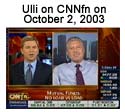|
MUTUAL FUND ARTICLES BY ULLI
G. NIEMANN
Articles for Free publication in your Newsletter or on your Website
Do Lifestyle Funds Provide Greater Security?
By Ulli G. Niemann
With the stock market stubbornly refusing to settle down and
smooth out, Wall Street has been scrambling to come up with "product" they
can sell to gun shy investors. One such new concept is the
Lifestyle fund; an extremely diversified package designed to
be the single fund in an investor's portfolio.
There are two general types of these funds, in which assets
are spread out across a wide range of stocks and bonds. In
one, securities are held directly, in the other, assets are
held through other funds.
Fidelity's Freedom 2030 is an example of the first type. It
targets a specific retirement date, and the cash and bond stakes
rise as that date approaches. This type of fund has created
a perception among investors that its value will not drop and
that it is safe. But, in fact, these are no safer than a standard
mutual fund.
Since we sold all of our investment positions on October 13,
2000 and preserved our capital, Fidelity Freedom 2030 has lost
39% (through 2/21/03). Do you think that's an isolated incident?
I'm not picking on Fidelity, but here are some of their other
Lifestyle funds with returns over the same period:
Fidelity Freedom 2020: -34%
Fidelity Freedom 2010: -22%
So much for perceived safety.
The other Wall Street bright idea is the fund of funds (FOF).
It sounds good, but it actually creates a double layer of costs;
the cost of purchasing the fund itself, and then the expenses
of the mutual funds the FOF purchases.
Take for example, the Enterprise Group of Funds. It shows
an expense ratio of almost 2% plus a sales charge of 4.75%
according to Morningstar. Tack on the underlying expenses and
you're paying out more than 3% a year in investment expenses.
If you're a new investor (with less than $10k), and have your
account at a discount broker, you can add a minimum of 1% per
year in fees just for the privilege of having an account. That
brings the total up to 4% in annual expenses. Talk about adding
insult to injury.
FOFs are sometimes being touted as the only fund you need
no matter what the investment climate. So, let's compare to
see how the Enterprise fund of funds performed during the same
period as mentioned above for the Freedom funds:
Enterprise Group of Funds: -35%.
The bottom line is that no matter what type of mutual fund
you choose, or what anybody claims it will do for you, you
must be vigilant and see if it does what you were told it would.
In investing, there is simply no such thing as a sure thing.
Sure you need to know how to recognize a good investment. But
just as important-maybe even more important-you must know when
to recognize that a good investment idea didn't work out, cut
your loss, and sell.
© Ulli G. Niemann
Ulli
Niemann is an investment advisor and has been writing about
objective, methodical approaches to investing for over 10
years. He eluded the bear market of 2000 and has helped countless people
make better investment decisions. To find out more about
his approach and his FREE Newsletter, please visit: www.successful-investment.com.
You have permission to publish this article electronically
or in print in your Newsletter, on your website, or in your
E-Book, as long as the author's Resource Box is included
with the article.
|










